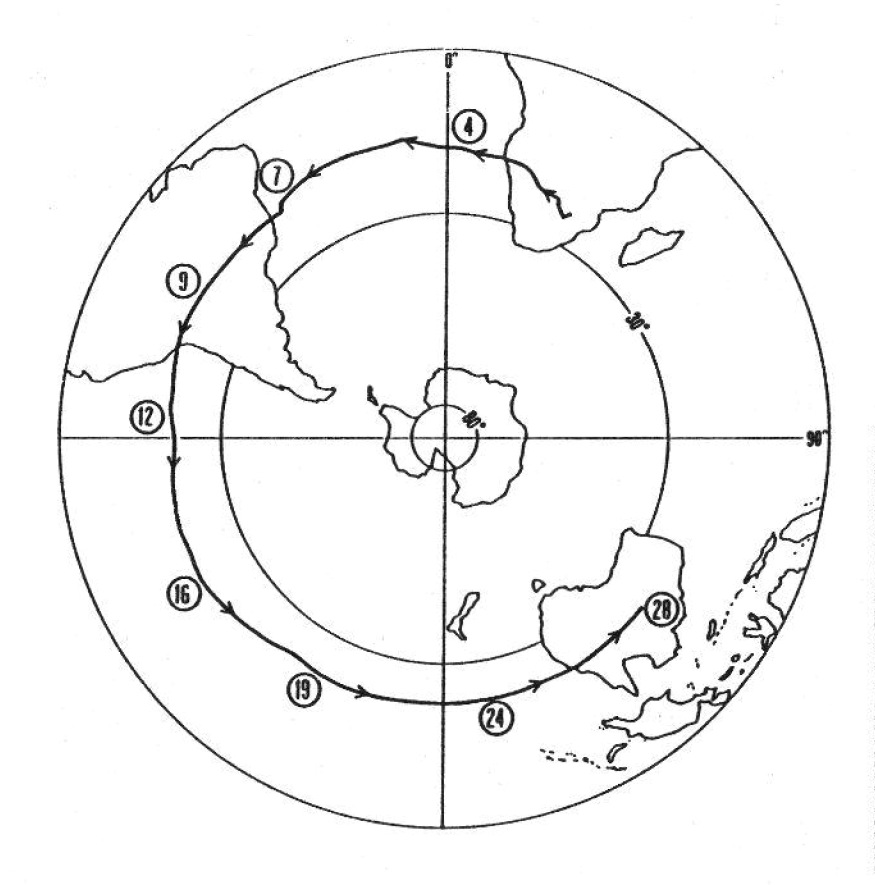Purpose of the flight and payload description
The objective of the flight was to transport in a long duration flight a magnetometer payload in a first attempt at performing a quasi-circumterrestrial continuous magnetic anomaly profile. This experiment formed part of a program initiated in 1984 by the Departement de Geomagnetisme of the Institut de Physique du Globe de Paris to determine the intermediate wavelength (50-1000 km) magnetic anomaly field of crustal and lithospheric origin.
The magnetic sensor (scalar) was located 6 m below the gondola within a thermal insulator. Altitude (pressure) variations were accurately recorded with a high-precision barometer. Horizontal position determination was obtained two or three times a day from the Argos system, with an accuracy of a few miles. Because of this poor accuracy, the uncertainty on the value of the main field at the location of the balloon was larger than the anomaly field. Therefore this latter field cannot be determined with the data gathered during this flight. Indeed, its purpose was merely to assess the feasibility of such magnetic measurements on a long-duration (several weeks) stratospheric flight. In particular, it had to be checked whether a proton precession magnetometer can operate under the stringent temperature conditions encountered in stratospheric flights with temperatures ranging between -20°C and -70°C during each altitude excursion.
The MONTGOLFIER INFRARED
The balloon used as platform for this mission is the so called Infrared Montgolfier (MIR) developed by the Service d'Aéronomie of the CNRS and CNES in 1977 in an attempt to meet the needs of long-duration flights. The MIR is a hot air balloon "open at the bottom" made of 2 different materials: a top part of aluminized Mylar 12 µm thick making a cavity for absorbing ascendants infrared and block any re-emission toward the sky and the bottom part made of linear polyethylene 15µm thick, an infrared transparent material and tough at cold (-80°C). It only uses helium to gain altitude at takeoff. Their reflective cover provides lift heating the air inside the envelope by the sun during the day or by the infrared radiation coming from the earth during the night. During the day, the MIR flies at an altitude of about 28 km to 32 km while at night it floats between 18 and 22 km depending on the infrared flux radiating from the overflown area and the temperature of the air parcel. It could carry a scientific payload of about 50 kg.
Details of the balloon flight

Balloon launched on: 11/19/1988
Launch site: Paardefontein Tracking Station, Pretoria, Southafrica
Balloon launched by: Centre National d'Etudes Spatiales (CNES)
Balloon manufacturer/size/composition: Montgolfier Infrared 36.000 m3
End of flight (L for landing time, W for last contact, otherwise termination time): 12/17/1988
Balloon flight duration (F: time at float only, otherwise total flight time in d:days / h:hours or m:minutes - ): 28 d
Landing site: Last known position above Australia
The magnetometer experiment was launched under a MIR balloon on November 19, 1988, from the Satellite Tracking Station of Paardefontein near Pretoria, South Africa. It was terminated after 28 days of operation when all on-board batteries were depleted. At this time the MIR balloon was still operating properly. Because one of the ground stations used for data reception did not worked properly, only 19 days of data could be collected. It allowed the scientific team to plot a 17,000-km continuous magnetic profile (the longest ever) above South Africa, the South Atlantic Ocean, South America, and the eastern South Pacific. Using Argos positioning data (53 points), was possible to compute a first-order estimate of the main field value at several points along the profile (at 25-km altitude). They confirmed that the measurements obtained were representative of the Earth's magnetic field and that no large systematic drift of the magnetometer has been observed during the flight.
External references
- The French program of circumterrestrial magnetic surveys using stratospheric balloons Eos Transactions American Geophysical Union 72(9) - 1991
16129If you consider this website interesting or useful, you can help me to keep it up and running with a small donation to cover the operational costs. Just the equivalent of the price of a cup of coffee helps a lot.

